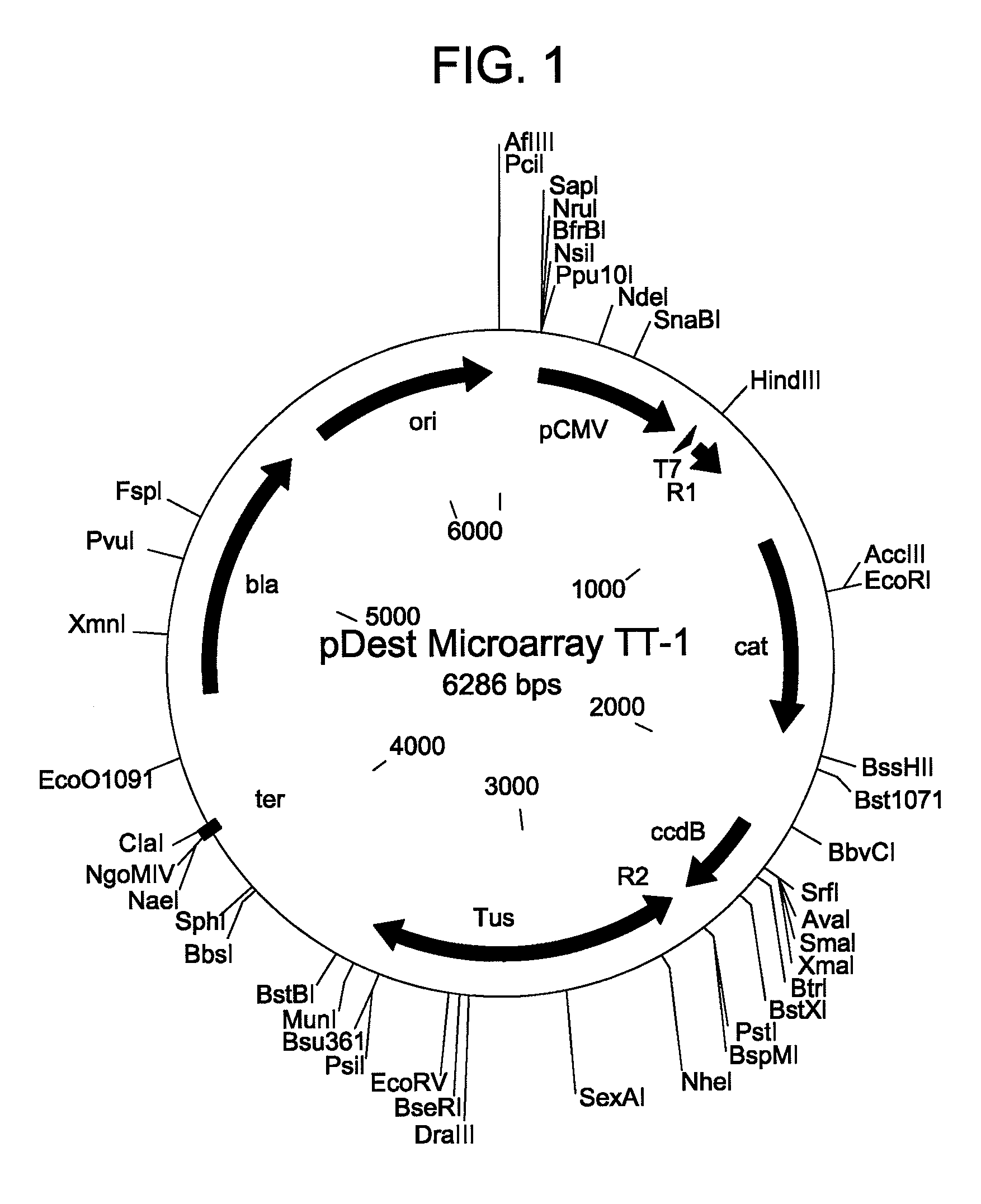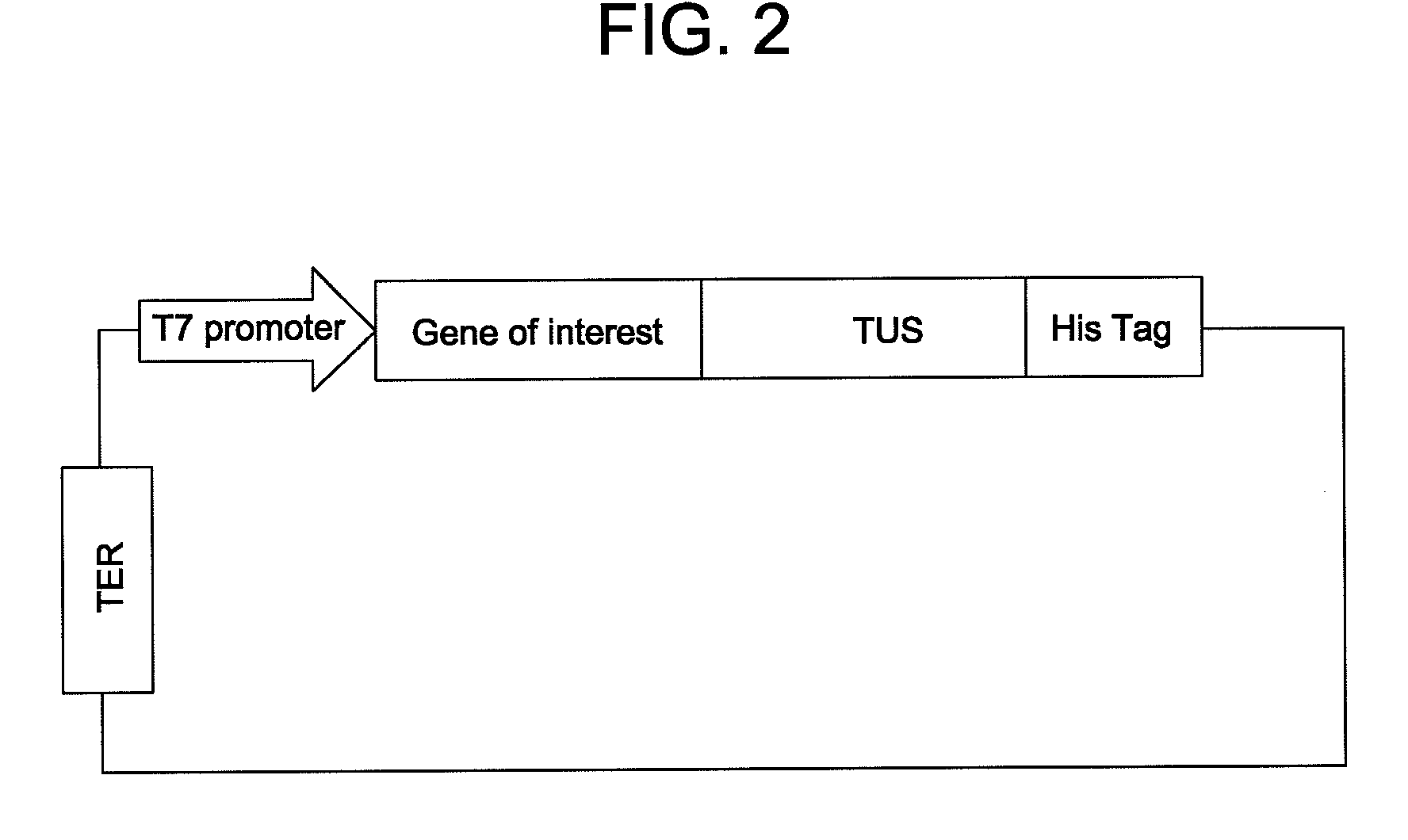In situ assembly of protein microarrays
a protein microarray and assembly technology, applied in the field of in situ assembly of protein microarrays, can solve the problems of limited use of target protein microarrays, labor-intensive current protein microarray technology, and no high-throughput expression system that produces significant yields of mammalian proteins of sufficient purity
- Summary
- Abstract
- Description
- Claims
- Application Information
AI Technical Summary
Benefits of technology
Problems solved by technology
Method used
Image
Examples
example 1
[0053]This example demonstrates the production of a protein microarray in accordance with the invention.
Construction of Base Microarray Plasmid
[0054]A base microarray plasmid vector (pDest Microarray TT-1) containing a Ter site and a Tus protein for cloning genes of interest was constructed. First, a destination vector was made with E. coli Tus protein as a carboxy fusion partner. A Tus protein with greater affinity for a Ter sequence (Tus E47Q) was amplified from plasmid DNA by standard procedures (see Henderson et al., Mol. Genet. Genomics, 265: 941-953 (2001)). The sequences of the oligonucleotides used for the Tus amplifications are set forth below as SEQ ID NO: 8 and SEQ ID NO: 9. Restriction sites NheI and MunI are indicated as bold and underlined. A six-histidine tag (underlined and italics) was incorporated in the reverse primer so to enable downstream identification of Tus.
Forward-(SEQ ID NO: 8)5′-ATTTTAGCT AGCGGAGGTGCGCGTTACGATCTCGTAGACCGACTC-3′Reverse(SEQ ID NO: 9)5′-TATA...
example 2
[0068]This example demonstrates a method of analyzing interactions between two proteins.
[0069]Microarray plasmids and microarrays are generated as described in Example 1. Specifically, plasmids are generated containing nucleic acid sequences encoding fusion proteins containing combinations of a first protein (“protein A”), a second protein (“protein B”), an epitope that can be detected with an antibody, and / or a DNA-binding protein (DBP) that recognizes a DNA sequence present in a spot on a microarray. The DNA-binding protein may be located on one or more expression plasmids, or on a separate plasmid or oligonucleotide in each spot. To test for an interaction between proteins A and B, expression cassettes encoding fusion proteins containing protein A, protein B, an epitope, and / or a DNA-binding protein can be cloned into plasmids according to Table 2. The order of the nucleic acid sequences set forth in Table 2 is not fixed, and the optimal arrangement of nucleic acid sequences can ...
example 3
[0085]This example demonstrates the production of a protein microarray in accordance with the invention.
[0086]Using the methods disclosed in Example 1, expression plasmids comprising a wild-type Ter site and encoding a fusion protein comprising (a) one of 14 different proteins, (b) a Tus protein, and (c) a poly-histidine sequence were immobilized onto the surface of a microarray. The 14 different proteins included integrin-B, Stat4, cyclin dependent kinase (CDK), interleukin-13 (IL-13), F-box, importin alpha, interferon gamma (IFNG), Cyclin D2, β-globin, hypoxia-inducible factor 1 (HIF-1), Fos, Jun, green fluorescent protein (GFP), and Chk2. The following expression plasmids served as negative controls: (a) a Fos-encoding plasmid lacking a Ter site, (b) a GFP-encoding plasmid lacking a Ter site, and (c) a plasmid lacking any expression cassette. The expression plasmids in the array were incubated in a cell-free rabbit reticulocyte transcription / translation extract as described herei...
PUM
| Property | Measurement | Unit |
|---|---|---|
| molecular weight | aaaaa | aaaaa |
| dissociation constant | aaaaa | aaaaa |
| dissociation constant | aaaaa | aaaaa |
Abstract
Description
Claims
Application Information
 Login to View More
Login to View More - R&D
- Intellectual Property
- Life Sciences
- Materials
- Tech Scout
- Unparalleled Data Quality
- Higher Quality Content
- 60% Fewer Hallucinations
Browse by: Latest US Patents, China's latest patents, Technical Efficacy Thesaurus, Application Domain, Technology Topic, Popular Technical Reports.
© 2025 PatSnap. All rights reserved.Legal|Privacy policy|Modern Slavery Act Transparency Statement|Sitemap|About US| Contact US: help@patsnap.com



